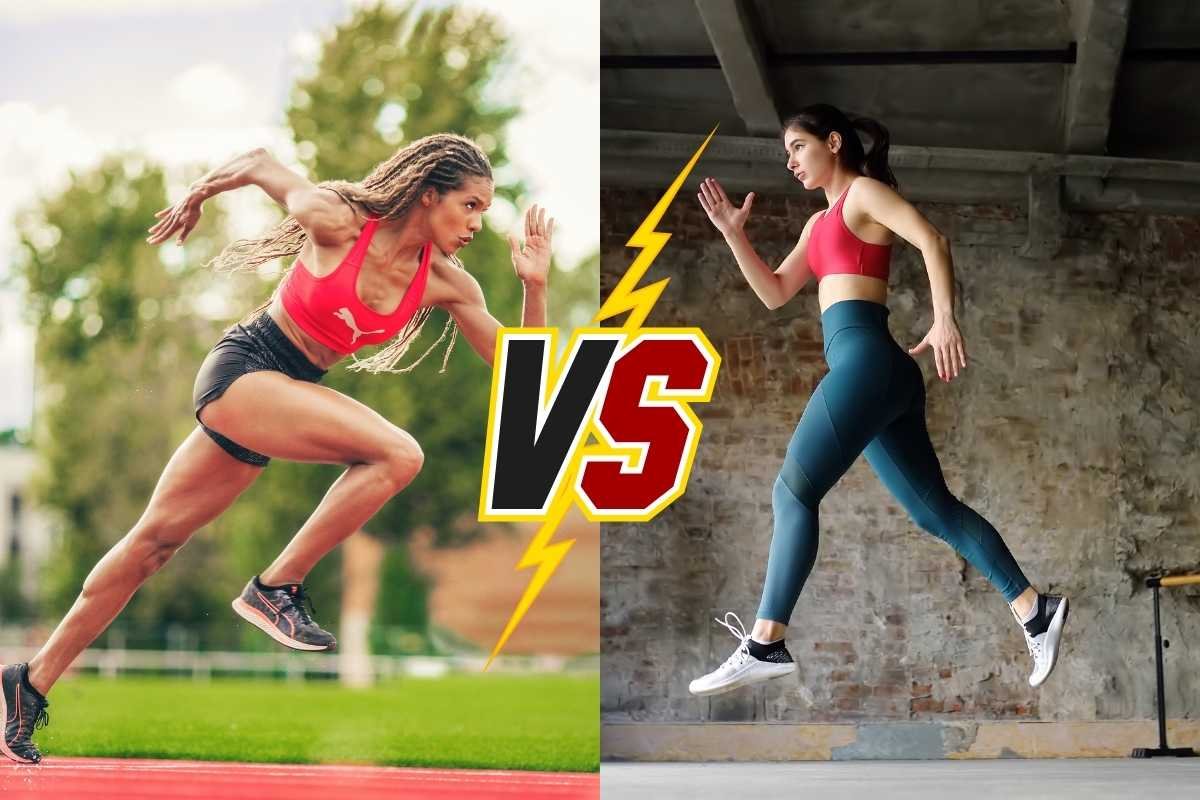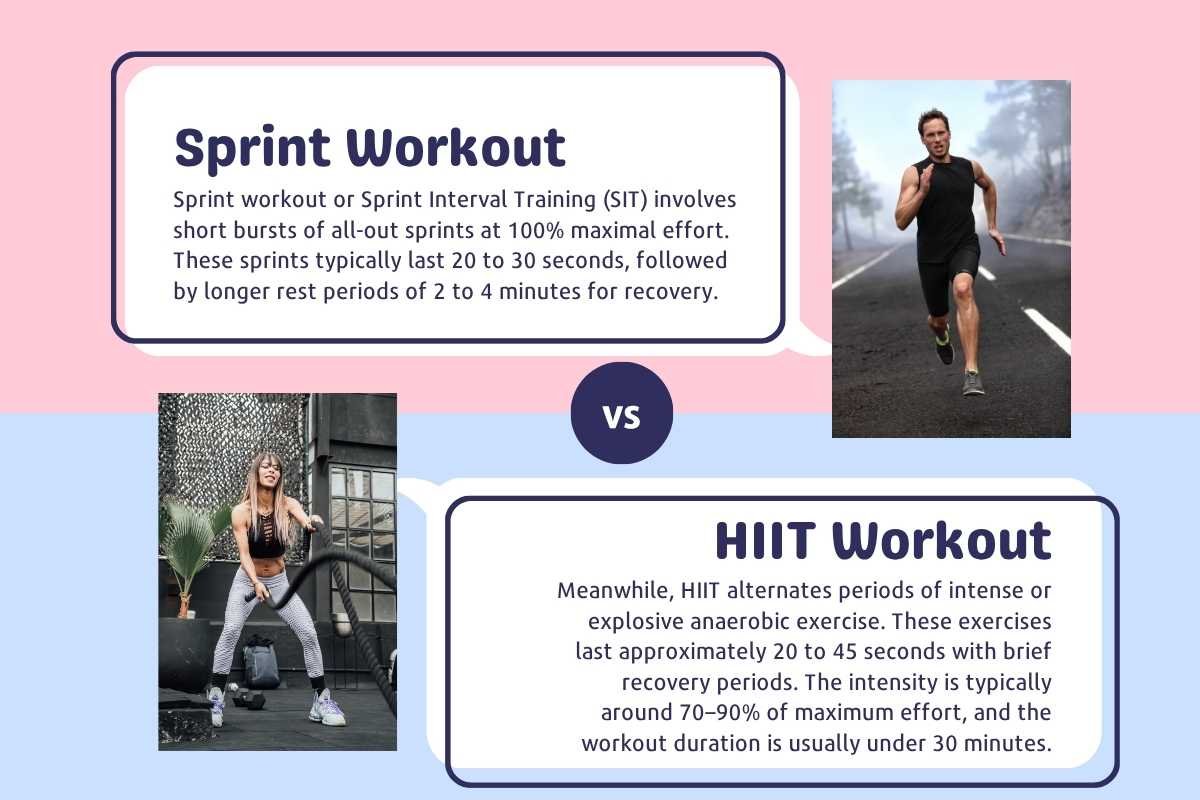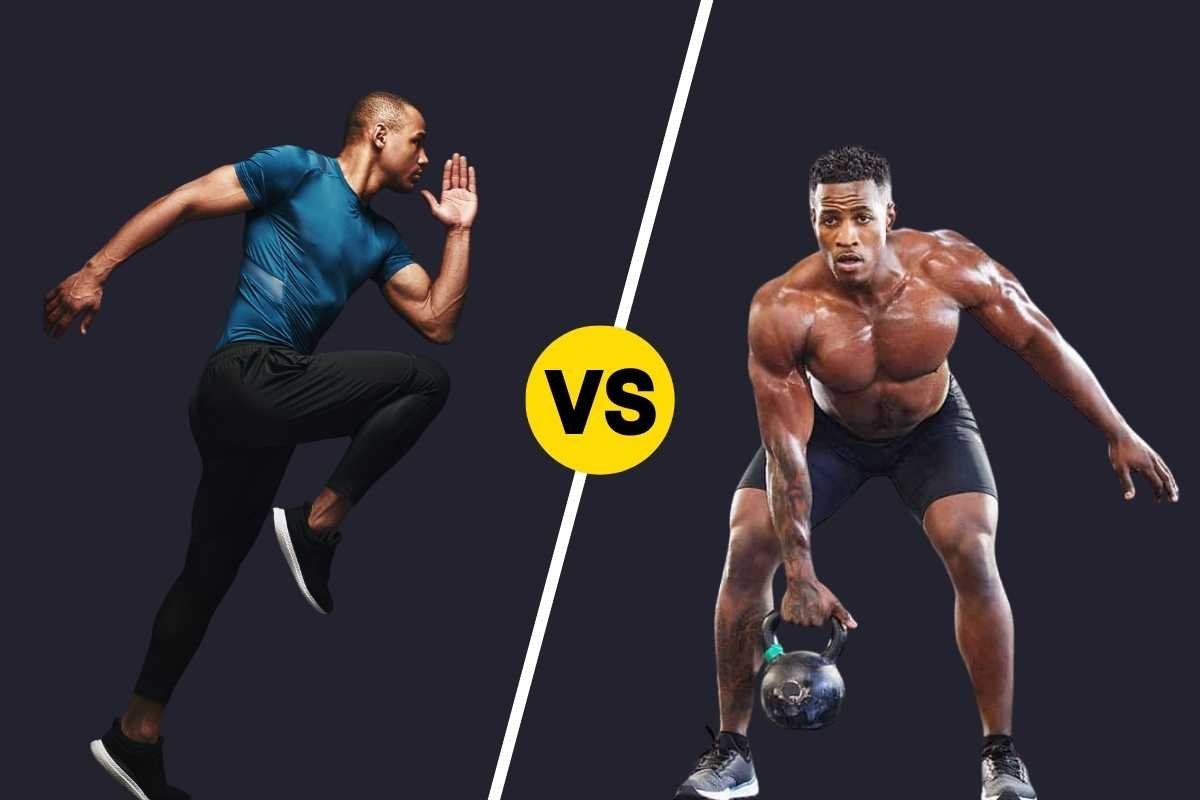Sprint Workout vs HIIT: Breaking down the science for quicker results
- Get link
- X
- Other Apps
SIT offers faster fat loss, HIIT is safer for beginners. Learn the 5 key differences of Sprint workout vs HIIT to choose your workout plan!

High-intensity interval training (HIIT) and all-out sprint workouts, or SIT, are the top choices for getting results in minimal time. You’ve heard both deliver incredible calorie burn, but which one truly wins the fat-loss game? That’s exactly what we will try to learn today. We’re taking a scientific look to settle the debate: Sprint workout vs HIIT.
We’ll break down exactly how these two powerful routines differ. Knowing the facts about a Sprint workout vs HIIT helps you stop guessing and choose the precise regimen you need to reach your health and body goals faster.
Before we start, it is important to understand that this blog is for educational purposes and not medical advice.
Sprint workout vs HIIT: What are they?

Sprint Workout:
Sprint workout or Sprint Interval Training (SIT) involves short bursts of all-out sprints at 100% maximal effort. These sprints typically last 20 to 30 seconds, followed by longer rest periods of 2 to 4 minutes for recovery.
This approach is designed as a maximum effort challenge with brief, intense work periods and longer rest. And this is what differentiates it from other forms of interval training. Sprint workouts are generally very intense and shorter overall in duration due to the maximal effort required.
What does research say about SIT?
A study was conducted in 2016 with 14 people ages 40–50 and 14 people ages 20–30. In the study, the groups performed 4–6 30-second all-out sprints with 4 minutes of active recovery in between. After completing this workout 3 times per week for 4 weeks, both age groups had improved anaerobic and aerobic fitness.
Another 2018 study of 16 trained trail runners for three weeks showed that when they completed 4 to 7 bouts of 30 seconds of maximal intensity sprinting. And interspersed with 4 minutes of recovery. They had improvements in running performance metrics like endurance, strength, and power.
Drawbacks:
Sprinting at maximal effort puts significant stress on muscles, joints, and tendons. This increases the chances of strains, sprains, or other injuries if not done carefully or without proper warm-up.
SIT requires a high baseline level of fitness and muscular strength. It is not suitable for beginners or people with chronic pain or joint issues. If you have certain medical conditions like heart problems, sprinting workout is advised against.
HIIT:
Meanwhile, HIIT alternates periods of intense or explosive anaerobic exercise. These exercises last approximately 20 to 45 seconds with brief recovery periods. The intensity is typically around 70–90% of maximum effort, and the workout duration is usually under 30 minutes.
HIIT incorporates short bursts of vigorous activity followed by rest or lower intensity. It aims to significantly raise heart rate and improve cardiovascular fitness, muscle conditioning, and calorie burn.
What does research say about HIIT?
A study published in 2025 showed that HIIT significantly improves cardiovascular health. It can help in reducing blood pressure and cardiac output. It can also improve vascular endothelial function.
According to a study published by the International Journal of Environmental and Public Health, HIIT increases aerobic capacity (VO2 max), fat oxidation, and metabolic adaptations in your body. This leads to reduced body fat and improved lipid profiles.
Drawbacks:
Fast-paced, complex movements combined with fatigue can lead to overuse injuries and joint strains. HIIT can cause muscle pulls due to compromised form. High cortisol levels from intense strain can lead to mental and physical fatigue. And if recovery is insufficient, it can potentially cause burnout.
Excessive high-intensity exercise may pose risks to individuals with pre-existing cardiac conditions or without proper exercise adaptation. Relying solely on HIIT without including other exercise types may not provide balanced fitness.
So, how are they different from each other? Let’s talk about it.
Sprint workout vs HIIT: 5 Key Differences
There are five key differences between a Sprint workout vs HIIT. Here’s what they are
| Feature | Sprint Workout | HIIT Workout |
|---|---|---|
| Intensity | Maximal / All-Out (100% effort) (Supra-maximal effort, pushing past VO₂ max) | High Intensity (80–95% effort) (Near-maximal effort, typically at or near VO₂ max) |
| Work Interval Duration | Very Short (≤30 seconds) | Short to Moderate (30 seconds – 4 minutes) |
| Rest/Recovery Protocol | Longer, Full Recovery (Work-to-rest ratio 1:3 or 1:5, e.g., 20s sprint : 100s rest) | Shorter, Partial Recovery (Work-to-rest ratio 1:1 or 1:2, e.g., 1 min work : 1 min rest) |
| Primary Energy System | Anaerobic (non-oxygen) system for explosive power | Primarily Anaerobic during work, but also significantly taxes the Aerobic system |
| Training Focus | Raw speed, power, muscle fiber recruitment, and maximum fat-burning efficiency | Endurance, work capacity, cardiovascular conditioning |
| Time Efficiency | Extremely High (Less total work time due to longer rests) | High (Workouts typically longer than SIT to accumulate enough high-intensity work) |
Sprint workout vs HIIT: Which is better for fat loss?

Now let’s talk about the main objective of this blog: Sprint workout vs HIIT, which one is better for losing fat?
While both of these exercises are good for your cardiovascular health, the SIT or Sprint workout is preferably better for losing fat. According to a review of 75 studies on Sprint and HIIT by RunRepeat, SIT significantly outperformed HIIT in Body Fat Percentage (BF%) reduction while requiring 60.84% less time spent exercising than HIIT.
SIT sessions also burn more fat despite shorter and fewer sprint intervals compared to HIIT’s high-intensity intervals. Additionally, SIT is more time-efficient compared to HIIT and yet achieves greater fat loss results. This efficiency is attributed to the maximal effort and intensity of SIT, pushing the body further out of its comfort zone, thereby stimulating stronger fat-burning biological responses.
But beyond fat loss, what else can be accomplished by these exercises?
Sprint workout vs HIIT: What to choose and why?
Now, let’s try to understand which exercise regimen to choose between the two. Both of them are good for your cardiovascular health and help reduce fat. Though SIT is more efficient at fat loss.
So, how do you decide which exercise regimen you want to follow? Here’s a brief about Sprint workout vs HIIT and when to choose either of them to help:
| Aspect | Sprint Interval Training (SIT) | High-Intensity Interval Training (HIIT) |
|---|---|---|
| Best For | Advanced/Trained athletes with a solid fitness foundation | Beginners to intermediate fitness levels |
| Primary Goal | Maximal performance gains in the shortest time | General fitness, endurance, and full-body conditioning |
| Time Efficiency | Extremely time-efficient (2–5 minutes of actual work can be effective) | Time-efficient but usually requires more total work time than SIT |
| Cardiorespiratory Benefits | Equal to or greater than HIIT in less time | Excellent for building aerobic endurance and VO₂ max |
| Muscle Recruitment | Trains fast-twitch muscle fibers and anaerobic system (explosive speed, power) | Trains both aerobic and anaerobic systems, with a broader endurance focus |
| Workout Structure | 100% all-out sprints with long recovery periods | High effort (80–95% max HR) with shorter recovery, more continuous work |
| Exercise Variety | Mostly sprint-based (cycling, running, rowing) | Wide variety (circuits with bodyweight, weights, ropes, cardio equipment) |
| Injury Risk | Higher (due to all-out sprinting and intensity) | Lower (still intense but less than SIT) |
| Best Outcomes | Explosive power, speed, maximum conditioning in minimal time | Overall endurance, aerobic capacity, fat burn, and full-body fitness |
Sprint workout vs HIIT Starter Kit: 4 Workouts to Try Today

Here are a few sample workouts you can try for each of these exercise regimens.
Sprint Workouts
Workout 1: Pyramid Sprint Intervals
This workout builds sprint endurance and power by varying sprint lengths in a pyramid structure.
Steps:
- Warm-up: 5-10 minutes of light jogging and dynamic mobility drills.
- Sprint: Perform sprints of 15 seconds, then 30 seconds, then 45 seconds, then back down to 30 seconds, and finally 15 seconds, all at max effort.
- Recovery: Rest or walk for an equal time to the sprint duration after each interval.
- Repeat: Complete one full pyramid cycle; advanced individuals can repeat twice.
- Cool-down: 5-10 minutes walking and stretching.
- YouTube Tutorial: “Cardio (SIT) Sprint Interval Training | 28 Minute at Home Workout” by BodyFit by Amy
Workout 2: Hill Sprint Intervals for Power
Use hill sprints to improve power, strength, and cardiovascular fitness with less joint impact.
Steps:
Find a hill with a moderate incline, about 20-30 meters long.
- Warm-up: 5-minute walk followed by dynamic stretches like leg swings and high knees.
- Sprint: Sprint up the hill for 10-15 seconds at a controlled, powerful pace.
- Recovery: Walk slowly back down the hill to recover fully.
- Repeat: Perform 5-6 sprint and recovery cycles.
- Cool-down: 5 minutes walking on flat ground, followed by stretching.
- YouTube Tutorial: “HILL REPEATS RUNNING made EASY, by Ben Parkes!”
Also Read: Stop Wasting Hours on Cardio: Try This Proven Sprint Workout Plan Instead
HIIT Workouts:
Workout 1: 20-Minute Full Body HIIT
A no-equipment workout targeting strength and cardiovascular fitness.
Steps:
- Warm-up: 5 minutes jogging in place and dynamic stretches.
- Perform circuit: 40 seconds work, 20 seconds rest. Exercises include burpees, mountain climbers, jump squats, and push-ups.
- Repetition: Complete 4-5 rounds of the circuit.
- Cool-down: 5 minutes of stretching and deep breathing.
- YouTube Tutorial: “20 Minute Full Body Cardio HIIT Workout” by Fitness Blender
Workout 2: 15-Minute Beginner HIIT
Gentle intensity for newcomers, focusing on aerobic conditioning and fat loss.
Steps:
- Warm-up: 3-5 minutes of gentle jogging and arm circles.
- Perform circuits: 20 seconds work, 10 seconds rest intervals, including squats, lunges, jumping jacks, and wall push-ups.
- Repetition: Repeat the circuit for 15 minutes.
- Cool-down: Light stretching and walking.
- YouTube Tutorial: “15 Minute HIIT Workout | High Intensity Interval Training” by Global Triathlon Network
Also Read:
- Why 10-Minute HIIT Workouts Are Better Than an Hour at the Gym?
- Basic HIIT Routine for Beginners
- Exercising at Home: Unlocking Simple Ways to Stay Active and Healthy
Conclusion
Choosing between a Sprint Workout vs HIIT ultimately comes down to your personal goals and current fitness level. While both are highly effective, time-efficient tools for improving cardiovascular health and torching calories, the research suggests that Sprint Interval Training (SIT) is the more potent and efficient method for fat loss, achieving better body fat reduction in significantly less total exercise time.
For advanced athletes focused on maximal performance and time-efficient fat loss, SIT is the superior choice. However, for beginners or those seeking a wider variety of movements and a slightly lower injury risk, HIIT provides an excellent path to general fitness and endurance.
In the end the question is not what is better between Sprint workout vs HIIT. It is about staying consistent and determined to the process.
FAQs
1. What is the fundamental difference between a Sprint Workout vs HIIT?
The main difference is the maximal effort. SIT involves all-out, 100% maximal effort (supra-maximal), pushing past your peak oxygen uptake. HIIT involves high intensity, typically 80-95% of maximal effort (near-maximal), usually at or near your peak oxygen uptake (VO2max).
2. Which workout is better for a beginner?
HIIT is generally better for beginners to intermediate fitness levels. The intensity is high but not maximal, and the shorter work-to-rest ratio allows for more continuous conditioning. SIT is better suited for advanced or well-trained individuals with solid fitness.
3. Which has a higher risk of injury?
SIT has a higher risk of injury because it requires all-out, maximal sprints, which puts significant stress on muscles, joints, and tendons. HIIT is still intense but generally has a lower risk, provided exercises are performed with good form.
- Get link
- X
- Other Apps
Comments
Post a Comment